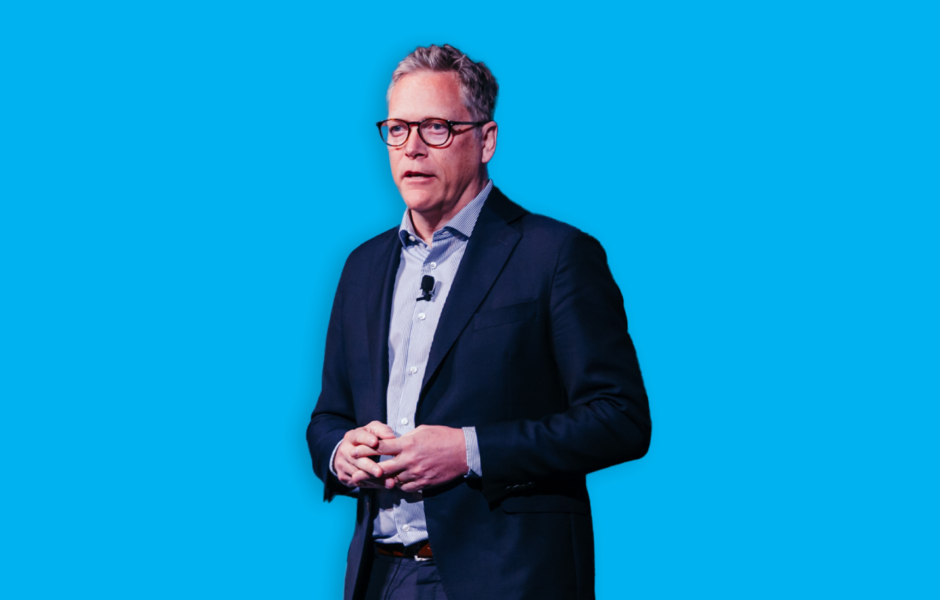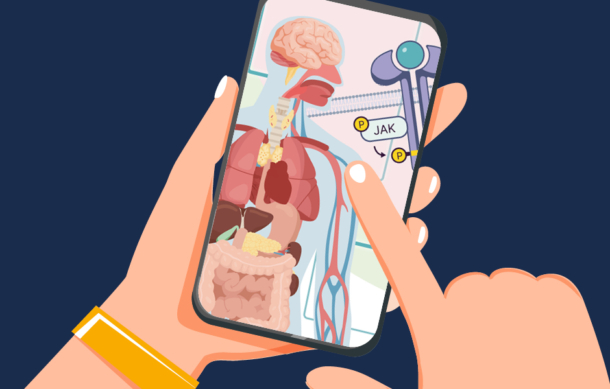Stefan Woxström, Senior Vice President Europe and Canada, AstraZeneca, talks about the need for future-proofing healthcare systems, incentivising innovation and the riddle of reimbursement
Words by Jade Williams
The sun peeps cautiously through the clouds on the final morning of Reuters Events: Pharma 2024 in Barcelona. Before delivering his morning keynote, AstraZeneca’s Stefan Woxström sits down with EMJ Chairman Dr Jonathan Sackier to discuss his career in pharmaceutical industry and his hopes for its future.
In his day-to-day, Woxström leads AstraZeneca’s commercial operations in more than 30 countries, driven by a passion for improving patients’ lives. He is a firm believer in the power of partnership to solve healthcare challenges, whether it is tackling the burden of chronic disease or transforming healthcare systems to make them more resilient and sustainable.
Having worked at AstraZeneca for more than 28 years, this seasoned leader has a wealth of experience in the pharma industry across many countries, from Ukraine to Turkey, the Nordics to Japan. Not far from his native Sweden, Woxström currently lives in Zug, Switzerland, where he spends his free time enjoying the wonders of nature, either on skis or by bike.
What’s been the driving force behind your 28-year tenure at AstraZeneca, and what are you most excited about for the future?
I’ve always been excited by the science at AstraZeneca, which drives everything that we do. When I look at the life-changing medicines we are bringing to patients, I’m blown away by the pace and scale of scientific innovation. Yet, to ensure patients can benefit from these medicines, it is not enough to focus on the science alone – we also have to focus on healthcare delivery. New innovation can’t reach patients if healthcare systems aren’t ready. And that’s more important now than ever because we’re bringing more advanced medicines and treatments to patients. Healthcare systems have to be ready for that – and they’re already struggling.
Health systems across Europe and Canada are under-resourced and overburdened, facing economic pressures as well as challenges posed by an ageing population, an increasing prevalence of chronic diseases, and the climate crisis increasing levels of ill health.
In response to these challenges, at AstraZeneca, we are prioritising how we can support sustainable health system reform. This will help ensure that current and future generations have access to high quality healthcare, a key pillar of a sustainable and resilient economy and society.
After all, it all starts with health and a healthy population. That’s why I believe our industry must prioritise supporting healthcare systems to prepare them for the future, working in partnership with governments, patients, healthcare professionals and other key stakeholders. This is what makes me excited to go to work every day.
Our industry must prioritise supporting healthcare systems to prepare them for the future
Drug discovery and development requires significant investment, and the funding market is currently quite challenging – how can we balance this?
Drug discovery and development, especially in innovative, complex areas like cell and gene therapy, requires significant investment with a high degree of risk. Having the right incentives in place is critical to ensuring companies take on that risk. One of these incentives is regulatory data protection (RDP), which grants a limited period of data exclusivity to protect early innovation. Traditional patents may not be as effective for new therapies like cell and gene therapy, compared to small-molecule drugs. RDP will therefore play an even bigger role for future medicines.
RDP is one of the major areas of focus for recently proposed changes to the EU’s pharmaceutical legislation and has been fiercely debated. Any changes are likely to set the whole framework for the next two decades, so its critical to get this right. Particularly when we think about maintaining Europe’s competitiveness in R&D, where in the US a biologic has 12 years of RDP. We need to find a way to encourage continued investment in innovation in Europe – more robust RDP is one piece of the solution.
What’s your perspective on the different regulatory environments of Europe and Canada?
Europe has come a long way. The mutual recognition procedure has made the regulatory process in the EU much faster and reliable, and it also provides more predictable timelines for achieving market access, supporting more equitable access to medicines across Europe. We have also seen some promising proposals to reform the EU’s pharmaceutical regulation which would accelerate the regulatory review process and enhance the use of real-world data to inform decision-making.
Canada is also a world leader in pharmaceutical regulation which is reflected in its dynamic life sciences ecosystem – last year we announced a major expansion to our R&D hub in Ontario. One example of this is Health Canada’s collaboration with the FDA on what’s called Project Orbis. This partnership accelerates the regulatory process for critical cancer drugs, helping to ensure these medicines can be made available to patients much faster.
However, the pricing and reimbursement processes in both Europe and Canada can be complex and lengthy, holding up access to patients. Early access schemes and innovative ways to ensure new medicines reach patients as quickly as possible are critical. We need to ensure that the benefit of expedited regulatory timelines can be realised for patients.
Does the industry need to rethink the clinical development process, so that drugs can get to market and reimbursed faster?
Clinical development and regulatory timelines have remained relatively stable over the past decade, but the industry is definitely moving in the right direction to improve this. We’ve seen improvements in the use of clinical evidence through advances in digital health technologies, particularly with registry data – whether retrospective, prospective or randomised registries.
What we are also starting to see now are dynamic databases, such as patient avatars – known as ‘digital twins’ – increasingly being leveraged to enhance and accelerate the clinical trial process. Digital twins are virtual models of real patients, based on their health data.
Digital twins can enable researchers to simulate how a specific person may respond to a medication, tailor treatments to an individual patient, and predict potential side effects. Digital twins can also be used to optimise drug development by simulating drug efficacy and safety before investing in clinical trials. And there is the potential to use this technology to create a virtual patient group that is representative of the entire population of a country.
I think we are moving towards a future where digital technology can provide a trusted data source for regulators to assess the safety and efficacy of new treatments.
How can we future-proof healthcare systems and prioritise health equity and health equality, to ensure that as many people as possible can access high quality healthcare?
Around the world, people’s lives and livelihoods are limited by preventable and treatable diseases, with certain communities facing systemic barriers to care due to factors ranging from genetics and gender to geography, race and socioeconomic status. This issue is only getting worse. Health disparities are widening within and between countries, worsened by an ageing population, a changing climate and a rise in chronic diseases. This in turn is putting pressure on health systems.
AstraZeneca is committed to improving health equity and transforming healthcare. We’re partnering with stakeholders to improve earlier and equitable detection, diagnosis and care across disease areas and embedding practices into our product development to drive equitable access including digital health and clinical trial diversity.
We are exploring a number of pilot projects to promote earlier detection and diagnosis, including in heart failure. There are about 15 million patients across Europe with heart failure. How can we make sure they get that critical diagnosis quickly? An example is our groundbreaking partnership with the NHS in Glasgow, which is revolutionising heart failure care. By slashing echocardiogram waiting times from 12 months to just 4 weeks, the pilot project delivers swift diagnoses and prevents hospital admissions.
The project also found that AI can reduce the standard analysis of an echocardiogram from 25 minutes to just one-minute, optimising healthcare resources and freeing up time for healthcare workers. Notably, this initiative also cuts ~8 kg of CO2e per patient annually, advancing sustainability alongside patient care. This model is now expanding across the UK and beyond.
Preventing chronic diseases from progressing keeps patients out of hospitals, which drives the bulk of treatment costs, and also results in improved, healthier lives.
AstraZeneca is committed to improving health equity and transforming healthcare
How can the industry do a better job at communicating new innovations and breakthroughs to the general public?
In addition to communicating new innovations and breakthroughs, I believe it’s important to raise public awareness of the benefits of being aware of your own health and acting early to seek medical help. For example, if you have chronic kidney disease – which affects around 100 million people in Europe – there’s a simple test you can do even at home that will give you an indication that you might need to see a doctor.
Alongside increasing people’s urgency to act on their health, we also need to make sure that health systems can accommodate, diagnose and treat patients early to stop disease progression.
Within the pharmaceutical industry there is tremendous expertise, resources and willingness to tackle the complexities of chronic disease management and support healthcare system transformation. However, collaboration at scale and pace is essential; no single entity can manage it alone. We’re working to bring together governments, healthcare professionals and industry to exchange knowledge and facilitate the scaling up of innovations that can transform healthcare and have a meaningful impact on patients’ lives.






